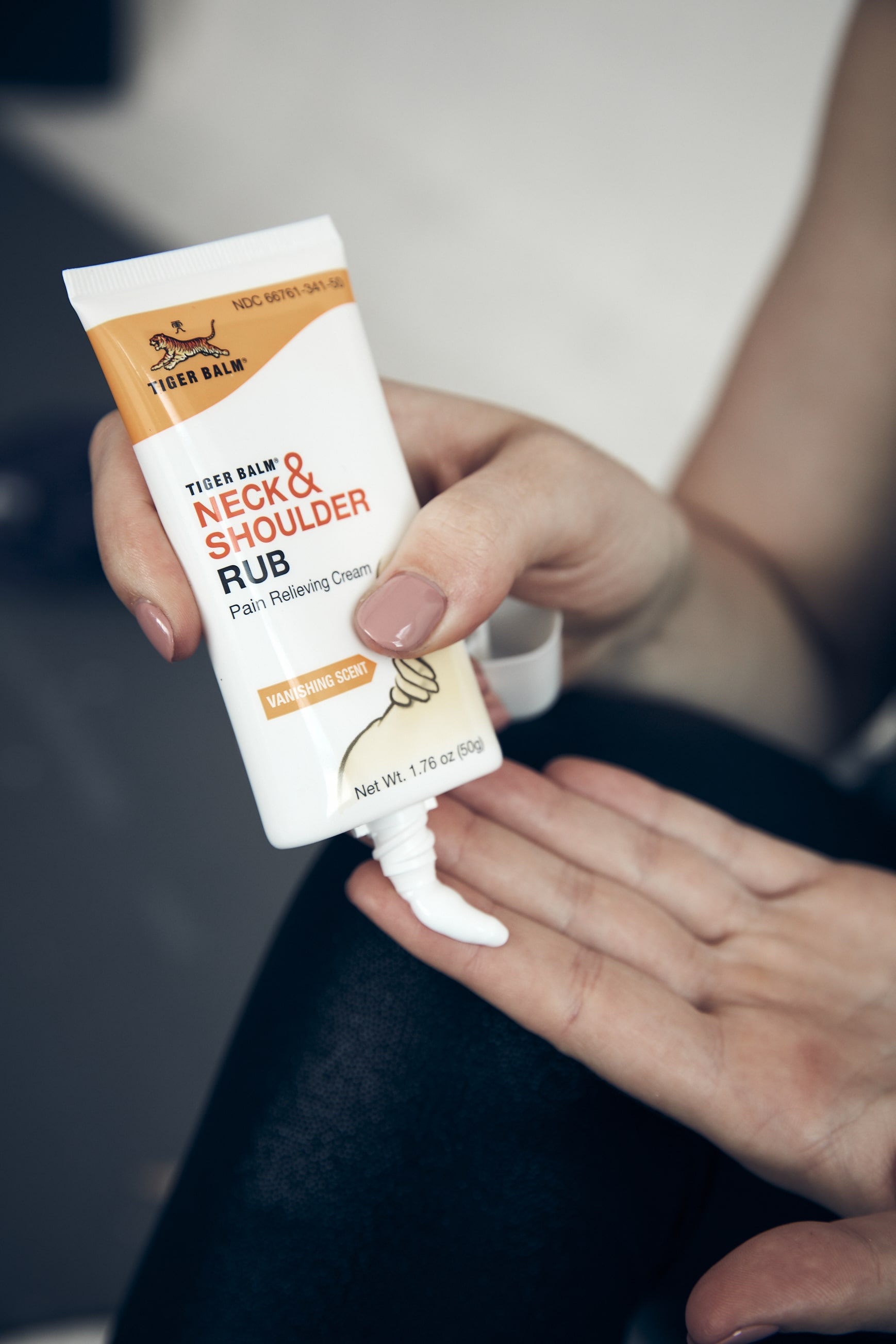Whether we’re desk-bound or actively moving on the job, we all experience aches, strains, and sores at some point. For example, perhaps you lifted a heavy box from the ground and felt a pull in your lower back. Maybe you’ve been working on your laptop all day with your back slouched and neck bent, and your muscles feel stiff. The discomfort you feel undoubtedly impacts your performance, limiting your ability to deliver your best.
In this article, we’ll discuss the various work-related muscle aches, sores, and strains, what you can do for pain relief, and the steps you can take to avoid them.
1. Neck and shoulder pain
Neck and shoulder pain has become a common ailment for many people who have left their offices and are now working from home. With employees setting up makeshift desks, especially those who do not have a proper workspace, it can be challenging to achieve an ergonomically-friendly workstation. This leads to poor posture, which can ultimately cause pain. How so?
A table that is too tall forces your shoulders to shrug, while a table positioned too low leaves you hunched over. Both of these scenarios result in tension in your neck and shoulder muscles, as well as your upper back. In addition, continuously flexing up and down, left and right, and between your laptop and monitor can also lead to neck strains. This further inflames the tendons in your neck, causing stiffness or tenderness or pain radiating to your shoulder blades. Such a condition is known as tendonitis, which requires immediate attention for pain relief, not just in the neck but also in the back and shoulders.
2. Lower back pain
Aside from aches in the neck and shoulders, an ill-equipped workstation can also cause pain in the lower back. Sitting on a chair that does not have adequate lumbar support leads to lower back pain. When you are seated, greater force is applied to the intervertebral lumbar discs in your spine. Supporting the natural lordotic curve of the lumbar spine is essential for ensuring stress relief on the soft tissues and joints.
Lower back pain can also be triggered when incorrectly lifting items off the ground or carrying bulky equipment without proper support. When performing tasks that require manual handling or squatting and bending, increased lower back curvatures can put you at risk of lumbar strains, too. Poor posture during manual work can also lead to neck and shoulder pain.
3. Carpal tunnel syndrome
According to the Centers for Disease Control and Prevention, carpal tunnel syndrome affects millions of people in the United States. Also referred to as median nerve compression, carpal tunnel syndrome occurs when the narrow tube of tendons in the wrist that connects the fingers to the median nerve is squeezed or compressed. This eventually leads to swelling of the tendons and tissues around the nerve, forcing pressure onto the median nerve and causing inflammation.
Carpal tunnel syndrome is usually caused by placing the wrist in a cramped position for a long time, such as while typing or performing intricate tasks like fixing a car. Numbness, tingling sensations, pain, and discomfort in your wrists are signs of carpal tunnel syndrome. Therefore, seeking help for pressure and strain relief is necessary, especially if you find it difficult to hold objects or perform small tasks such as unbuttoning a shirt.

The Tiger Balm pain relief kit for neck, back, shoulders and wrist
Apply Tiger Balm Extra Strength Ointment for pain relief or stiff and sore muscles in the neck, back, shoulders, or wrists. This reddish-brown balm combines the natural pain-fighting ingredients camphor and menthol to improve local blood flow. It also delivers a warm sensation to the affected area, reducing pain and swelling. It also contains cassia oil (cinnamon) for a refreshing scent.
For larger body areas, such as the lower and upper back, or the entire arm, consider Tiger Balm Liniment. The concentrated and fast-acting pain relief formula offers penetrating heat, perfect if you need a quick remedy while working through an exhaustingly busy day.
Suppose you need a practical pain relief solution when you’re at work or in social situations. In that case, Tiger Balm Neck & Shoulder Rub is an ideal choice. Providing comfort and relaxation to sore muscles and painful strains, this rub has a vanishing lavender scent. In addition, its fuss-free dispensing tube makes it a friendly on-the-go companion.
If you’re not a fan of ointments or creams, Tiger Balm also offers medicated patches. Whether you need to alleviate back pain, neck strains, or aches in the shoulder blades, each Tiger Balm Pain Relieving Patch effectively targets pain areas for hours. Stretchable and ventilated, these hydrogel patches contour to your body, so they work discreetly to reduce sore muscle pain and uncomfortable strains. Moreover, they aren’t messy or greasy, and they emit minimal odor, making them perfect for use under your clothing in any work environment.
Readily available across the United States, Tiger Balm products offer you pain-free comfort no matter where you work. Shop online or find a store near you to assemble your pain relief kit.

Be sure to keep your posture in check!
Just because you’ve got Tiger Balm pain relief patches, creams, and balms, it doesn’t mean you can overlook your posture at work.
Correct your posture with these helpful suggestions:
Posture tips when working from home
The first step to avoiding strains, sores, and aches is to set up an ergonomically friendly workstation:
- Get a chair with lumbar back support. If that’s not possible, then add pillows to provide the necessary support.
- When seated, ensure your back is reclined by 15 to 20 degrees to avoid tight hip flexors that otherwise would cause lower back pain.
- Whether you’re standing or seated, your table should be adjusted to a height that allows you to keep your elbows bent at a 90-degree angle.
- Position your computer monitor at eye level. Admittedly, this can be difficult when working on a laptop. Consider getting an external keyboard and place your computer on a stand at an appropriate height.
- Keep your feet on the floor. If they cannot reach, place them on a footstool or an equivalent.
- Take a break every 45 to 60 minutes. Stand up or take a walk for one to two minutes to change up your posture. This helps to avoid any build-up of muscle tension after staying stationary for prolonged periods of time.
Posture tips for manual work
If the bulk of your job involves manual handling or consistent movements, here are some quick tips to avoid musculoskeletal disorders such as pain or injuries:
- Before lifting an item, understand your capabilities, the nature of the load, and the conditions of the environment you’re in. For example, if the item is too heavy or the surface on which you will walk is uneven, avoid the manual work. Instead, employ lifting equipment.
- Do not lift objects from heights above your shoulders as this can cause an imbalance, resulting in a strain or injury to your neck, shoulder, and back.
- When lifting items from the floor, keep your back straight and your knees bent.
- While carrying a heavy load, reduce twisting and stooping, or reaching for other things.
- When carrying a load over a long distance, ensure you rest midway to change your grip.
- Keep the heaviest part of the load next to your body for better support.
- If you’re working on a task for an extended period of time, take breaks every 45 to 60 minutes. Stretch your back, neck, and arms, stand up or walk about for one to two minutes to loosen up any build-up of tension in your muscles.
A bad posture can impact your day-to-day life, even beyond work. So start correcting your posture today!




